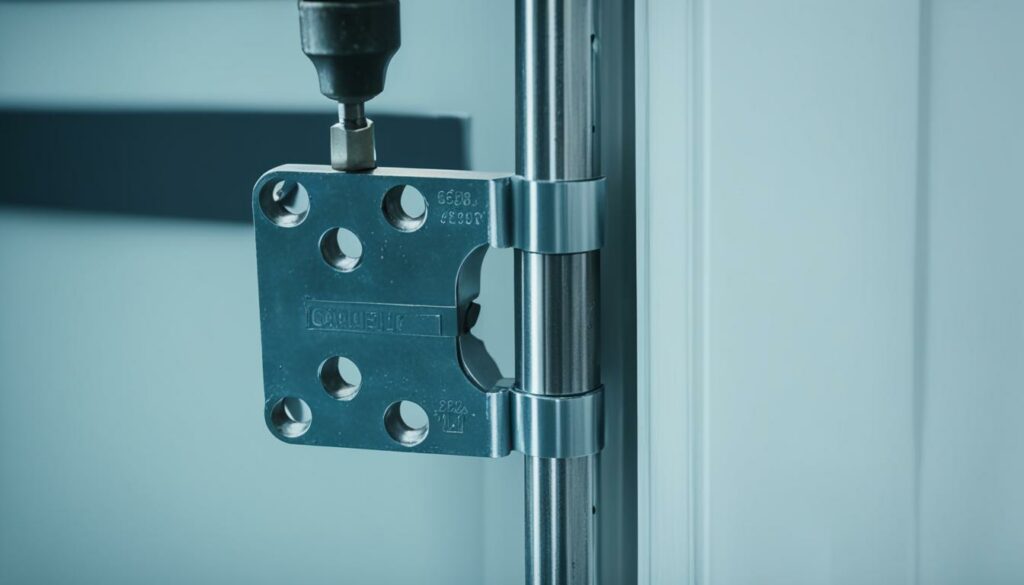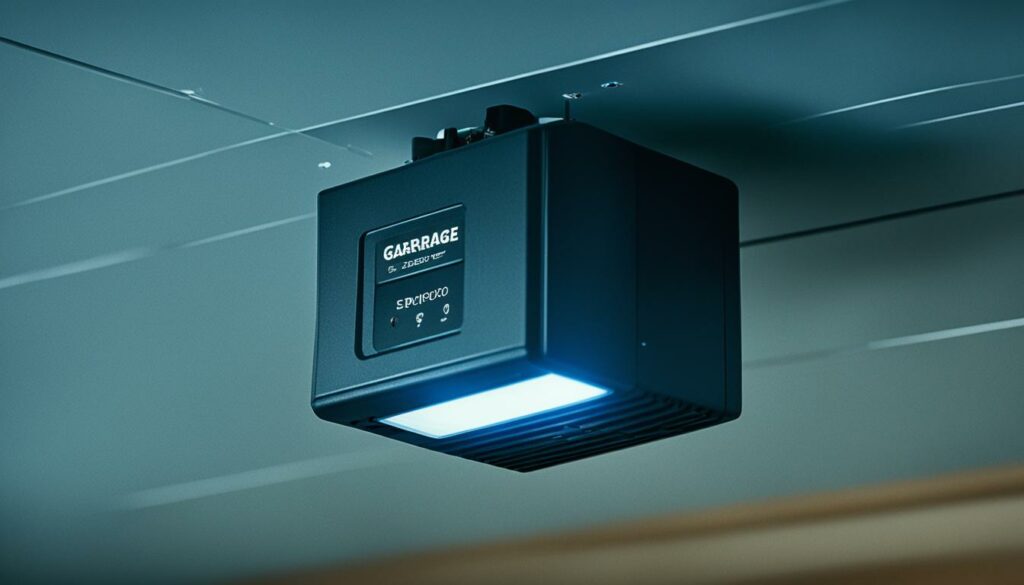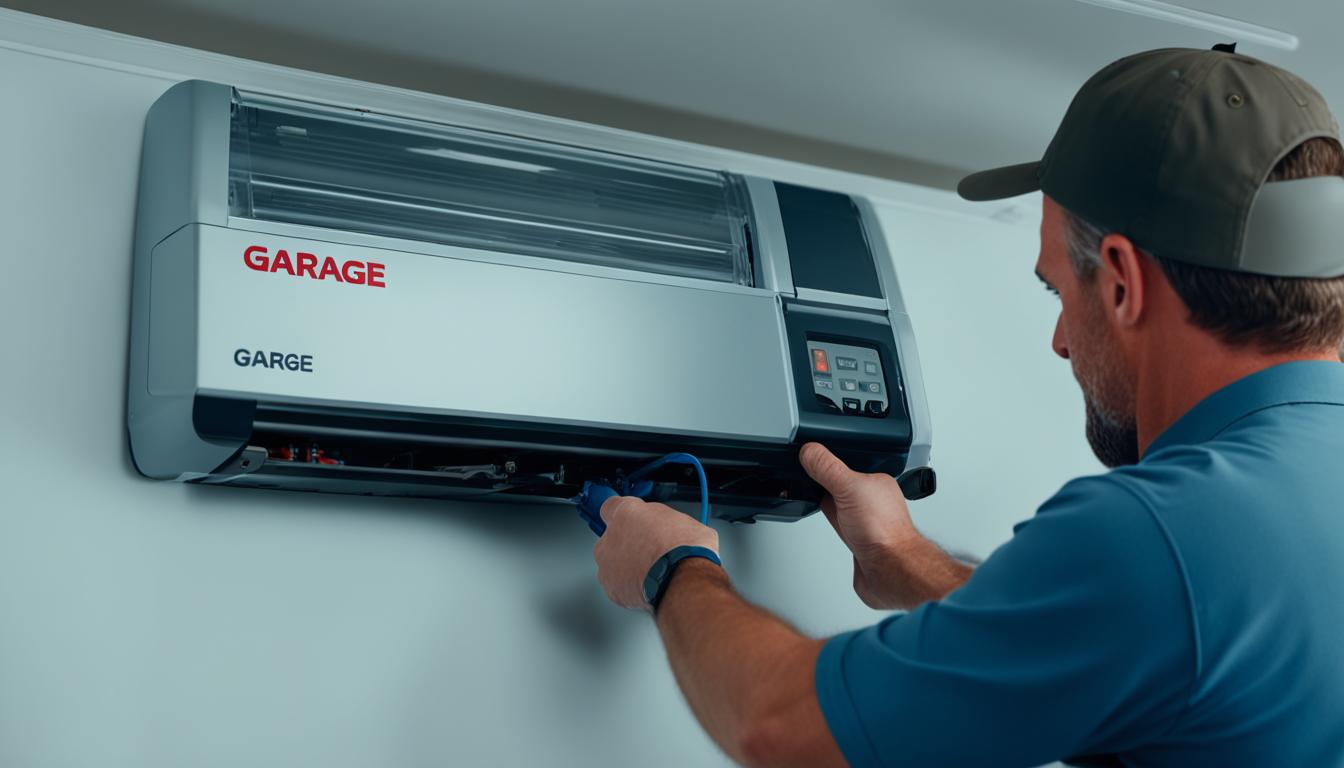Welcome to our DIY Garage Door Opener Installation Guide! If you’ve been putting off installing your garage door opener because it seems like a daunting task, fear not. We’re here to provide a step-by-step guide to make the process effortless. With our instructions, your garage door opener will be up and running quickly.
Installing a garage door opener may sound complicated, but with the proper guidance, it can be a smooth and easy DIY project. Whether you’re a seasoned DIY enthusiast or a beginner, our guide will help you confidently navigate the installation process. From installing a garage door opener with precision to troubleshooting any potential issues that arise, ensuring seamless functionality is key for hassle-free access to your garage.
From safety precautions to setting travel limits, we’ll cover everything you need to know to ensure a successful installation. So, grab your tools, and let’s start on the effortless installation of your garage door opener.
A person effortlessly installs a garage door opener with the help of a clear and easy-to-follow user manual. The tools required for installation are neatly organized nearby, and the person is shown confidently completing each step of the process without any difficulty. The overall image should convey a sense of simplicity and ease, emphasizing how easy it is to install the garage door opener.
Key Takeaways:
- Installing a garage door opener can be an effortless DIY project with the right guide.
- Familiarize yourself with the safety warnings and requirements before starting the installation.
- Gather all the necessary tools and ensure you have a complete kit before beginning the installation process.
- Proper door preparation is essential for a seamless fitment of the garage door opener.
- Setting travel limits and performing safety testing will ensure the safe and efficient operation of the opener.
Safety Warnings and Requirements
Before you begin the installation process, it’s crucial to familiarize yourself with the safety warnings and requirements. These safety guidelines are essential to prevent personal injury or property damage during installation.
Garage Door Opener Safety Warnings
- Do not operate the opener when children or objects are near the door. It’s essential to keep a safe distance to avoid accidents or injuries.
- Ensure the door is well-balanced and in good condition. An unbalanced or damaged door can lead to improper operation of the opener, causing accidents or damage.
- Connect the opener to a properly earthed power outlet. This ensures electrical safety and reduces the risk of electric shocks or malfunctions.
Adhering to these safety warnings ensures a safe and smooth installation process for your garage door opener.
Safety Requirements for Garage Door Opener Installation
- Read and follow the manufacturer’s instructions carefully. Each opener may have specific safety requirements and installation procedures that must be followed.
- Use appropriate personal protective equipment (PPE). When handling tools or working with electrical components, wearing safety gear such as gloves, goggles, and closed-toe shoes is essential.
- Secure the area and clear any obstructions. Make sure the space around the installation area is clear of debris, tools, and other objects to prevent tripping or accidents during the installation.
- Work with a partner. Someone assisting you during installation can enhance safety by providing extra eyes and hands.
Familiarizing yourself with and following these safety requirements will ensure a safe and successful garage door opener installation.
For more information about effortless installation of your garage door opener, contact us for expert garage door repairs in Murrumba Downs.
Why Safety Matters
“Safety should always be the top priority when installing a garage door opener. Taking the necessary precautions and following the recommended guidelines can help avoid accidents, injuries, and property damage. It’s important to remember that a garage door opener is a powerful and heavy piece of equipment, and mishandling or improper installation can have serious consequences. By prioritizing safety, you can enjoy the convenience and functionality of your garage door opener with peace of mind.”
Kit Contents and Tools Required
Gathering all the necessary tools and ensuring you have the complete kit is vital to start the installation process. The kit contains essential components to help you install your garage door opener successfully. Here are the essential items you can expect to find in a standard garage door opener kit:
| Kit Contents | Tools Required |
| Power drive unit Transmitters Weight bar Locking bar covers Fasteners Screws and washers |
Screwdrivers Adjustable wrenches Sockets Drill Ladder |
Having all the necessary tools and kit contents ready before you begin the installation will ensure a smooth and effortless experience. It’s important to notice all items from the kit as they are designed to facilitate a successful installation.
Now that you’re familiar with the kit contents and tools required, you’re ready to move on to the next section, where we’ll guide you through the door preparation and fitment process.
Door Preparation and Fitment
Before we install the garage door opener, it is crucial to prepare the door properly for fitment. Following these steps will ensure a seamless fitment of your door opener.
Door Preparation
First, let’s focus on door preparation to ensure a clean and safe installation process. Here are the essential steps:
- Clean the door guides to remove any dirt, debris, or obstructions hindering installation.
- Remove any existing locks or mechanisms from the door to ensure smooth fitment of the opener.
- Affix warning labels on the door to promote safety awareness during operation.
If your door has a handle, additional steps are necessary to prevent ballooning during operation:
Fit the weight bar to the door. This helps distribute the weight evenly and prevents excessive strain on the opener. Ensure the weight bar is securely attached to the door for optimal performance.
If your door does not have a handle, you can mark and drill holes to fit the weight bar:
Mark the appropriate locations for the weight bar installation and use a drill to create the required holes. Ensure the holes are aligned with the weight bar brackets for a secure fit.
Fitment of Weight Bar and Door Opener Mounting
With the door adequately prepared, it’s time to proceed with the fitment of the weight bar and mounting the opener:
- Fit the weight bar onto the door, aligning it with the brackets or holes previously prepared.
- Pin the door to the drum, ensuring a secure connection to prevent unwanted movement.
- Mount the opener onto the designated area, following the manufacturer’s instructions and guidelines for proper fitment.
By following these steps, you can ensure the fitment of your garage door opener is seamless and meets the necessary safety standards.

Setting Travel Limits and Safety Testing
After the opener is mounted, it’s crucial to set the travel limits to ensure proper operation. This involves initial preparation, setting the limit positions, resetting the door limit positions if needed, and adjusting the safety obstruction force. Once the travel limits are set, it’s essential to perform thorough safety testing. This includes testing the close and open cycles, manual door operation, and adjusting the safety obstruction force if necessary. Setting the travel limits and performing safety testing will guarantee your garage door opener’s safe and efficient operation.
Travel Limits: Initial Preparation
Before setting the travel limits, it’s essential to ensure that the door is fully closed. Disconnect the opener from the power supply to prevent any accidental movement during the adjustment process. This initial preparation ensures a safe and controlled environment for setting travel limits.
Setting the Limit Positions
To set the travel limits, locate the limit adjustment screws on the opener unit. These screws control the opening and closing positions of the door. Using a screwdriver, adjust the screws according to the manufacturer’s instructions. Turn the screws clockwise to decrease the travel distance and counterclockwise to increase it. Make minor adjustments and test the door’s movement after each adjustment.
Resetting Door Limit Positions
If you need to reset the door limit positions due to any changes in the door’s weight or track alignment, follow these steps:
- Disconnect the opener from the power supply.
- Manually move the door to the fully closed position.
- Reconnect the opener to the power supply.
- Test the door’s movement. Repeat the adjustment process to ensure the door opens and closes smoothly if necessary.
Adjusting the Safety Obstruction Force
The safety obstruction force of the garage door opener is responsible for sensing any obstacles or resistance in the door’s path. Proper adjustment of this force is crucial for the safe operation of the opener. To adjust the safety obstruction force:
- Locate the force adjustment dial on the opener unit. It is usually labeled “Force” or “Sensitivity.”
- Using a screwdriver, turn the dial to increase or decrease the force.
- Test the door’s movement by obstructing its path with a small object, such as a roll of paper towels.
- The force is adjusted correctly if the door reverses when detecting obstruction. If not, continue adjusting the force until the door reverses upon obstruction.

Safety Testing
“Safety is our top priority regarding garage door opener installation. That’s why thorough safety testing is a crucial step. We want to ensure that your garage door operates reliably and poses no risk to you, your family, or your belongings.”
– The Garage Door Experts
Once the travel limits are set and the safety obstruction force is adjusted, it’s essential to perform comprehensive safety testing. Follow these steps:
- Test the close and open cycles of the garage door multiple times to ensure smooth and consistent operation.
- Perform a manual door operation to verify that it can be opened and closed manually without any resistance or difficulties.
- If necessary, make further adjustments to the safety obstruction force to ensure the door reverses upon obstruction.
By dedicating time to setting the travel limits and conducting thorough safety testing, you can have peace of mind knowing that your garage door opener will function safely and efficiently. Now it’s time to move on to exploring the additional garage door accessories and features that can enhance your garage door opener experience.
Accessories and Additional Features
Regarding garage door openers, there are more than just the basic functionalities. Many openers come with a range of accessories and additional features that can enhance convenience and security in your garage. These additions allow you to customize your opener to suit your specific needs.
One of the popular accessories for garage door openers is the auxiliary Output. This feature provides an additional power source that can be used to connect and operate other devices. With an auxiliary output, you can power outdoor lights or even charge your electric vehicle conveniently in your garage.
Another useful accessory is the critical switch connection. This allows you to control the garage door opener with a key switch, providing an alternative method of operation. It’s convenient if you prefer a physical key over remote controls.
For those who prefer the convenience of remote operation, remote aerials are available as an accessory for some garage door openers. These aerials extend the range of your remote control, ensuring that you can open or close your garage door even from a distance.
Some advanced garage door openers offer an auto-close feature when the door is fitted with photoelectric beams. These beams detect any obstruction in the path of the closing door and automatically reverse the operation to prevent accidents or damage. The auto-close feature adds an extra layer of safety to the operation of your garage door opener.
Enhance the Functionality of Your Garage Door Opener
By understanding and utilizing these accessories and additional features, you can maximize the functionality and convenience of your garage door opener. Whether it’s powering external devices, using a key switch, extending the remote range, or adding auto-close for safety, these options allow you to customize your garage door opener to meet your specific requirements.
Now, let’s take a look at the table below for a quick comparison of popular garage door opener accessories and their features:
| Accessory | Features |
| Auxiliary Output | Provides additional power source for connecting and operating other devices such as outdoor lights or electric vehicle chargers. |
| Key Switch Connection | Allows control of the garage door opener using a physical key switch for those who prefer non-remote operation. |
| Remote Aerial | Extends the range of the remote control, allowing for operation of the garage door opener from a greater distance. |
| Auto-Close with Photoelectric Beams | Automatically closes the garage door when no obstacles are detected, enhancing safety and preventing accidents or damage. |
As you can see, various accessories and features are available for garage door openers that can enhance your garage’s overall functionality and security. Consider your specific needs and preferences when choosing the accessories that will best suit your requirements. With these additional features, you can make operating your garage door opener even more convenient and safe.
Conclusion
We hope this comprehensive guide has made installing your garage door opener effortless. Following our step-by-step instructions and heeding the safety warnings and requirements, you have assembled and installed your opener conveniently and efficiently.
Now, with your new garage door opener in place, you can enjoy the effortless operation of your garage door. Gone are the days of manually opening and closing the door, as your opener allows for convenient and seamless access to your garage.
Remember, to ensure the continued functionality and longevity of your opener, it is essential to maintain and service it regularly. This includes checking for any loose connections or parts, lubricating moving components, and keeping the sensors clean and free from obstruction.
FAQ
What are the safety warnings and requirements for installing a garage door opener?
To ensure safety during installation, it’s important not to operate the opener when children or objects are near the door, to ensure it is well-balanced and in good condition, and to connect the opener to a properly earthed power outlet.
What tools and kit contents are required for installing a garage door opener?
The necessary tools include screwdrivers, adjustable wrenches, sockets, a drill, and a ladder. The kit typically consists of the power drive unit, transmitters, weight bar, locking bar covers, fasteners, and various screws and washers.
How do I prepare the garage door and fit the opener?
Proper door preparation involves cleaning the door guides, removing locks or mechanisms, and affixing warning labels. If your door has a handle, you must fit the weight bar to prevent ballooning during operation. You can mark and drill holes to fit the weight bar if the door has no handle. Once the door is prepared, you can fit the weight bar, pinning the door to the drum and mounting the opener.
How do I set the travel limits and perform safety testing?
Setting the travel limits involves:
- Initial preparation.
- Setting the limit positions.
- Resetting the door limit positions if needed.
- Adjusting the safety obstruction force.
Once the travel limits are set, comprehensive safety testing is essential. This includes testing the close and open cycles, manual door operation, and adjusting the safety obstruction force if necessary.
What additional accessories and features can enhance the functionality of a garage door opener?
Many garage door openers have accessories such as auxiliary outputs, critical switch connections, and remote aerials. Some openers offer auto-close options with photoelectric beams for added safety.
Garage Door Opener Repair Near You
Experiencing issues with your garage door opener? Don’t stress—Jarred and the dedicated team at Impact Doors are here to help. Our prompt and reliable service ensures that your opener will be back in working order quickly. Contact us at (07) 5451 4022 for expert assistance with all your garage door opener needs.

